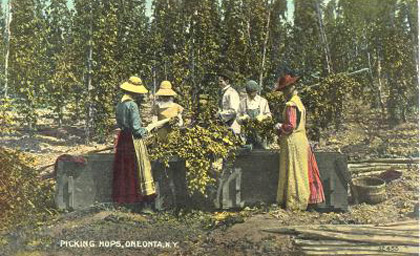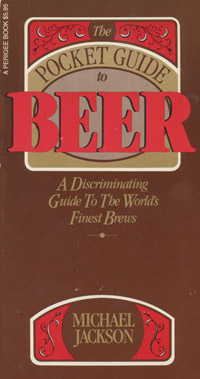Did I ever mention that my father was a professor of agricultural economics and wrote a textbook called The Economics of Futures Trading? I’m not saying that much of his brilliance rubbed off on me, but I grew up in an Illinois household where commodities were discussed almost every day. He always knew a range of prices (spot and futures) for grains such as soybeans and corn.
No hops, but what’s going on these days with both the short term supply of hops and the spot and futures prices would have made sense to him. This isn’t happening in a vacuum.
Our neighbor across the street ran a grain elevator and one next door sold tractors and farm implements. I only needed a look at the Christmas presents neighborhood kids were getting to know if it had been a good year or bad.
When I was a kid we’d go for Sunday drives in the country to see how the crops were progressing. In the fall we’d drive by grain elevators. In bumper years you’d see mountains of grain piled all around because there wasn’t enough room to process it all.
And prices sucked. No wonder almost none of the kids I knew who grew up on farms ended up being farmers.
The same situation has existed with hops since beer became an industrial product in the 19th century. There have been boom years and bust years.

Consider this from a feature called “A Glass of Beer” that appeared in Harper’s New Monthly Magazine in October of 1885:
No product of the soil varies more in price than the hop. Having but a single available use, and deteriorating rapidly with age, a year which gives to Germany, England, and the United States a season of average productiveness would create an excess over consumption sufficient to reduce values far below the cost of cultivation. Witness the low prices of 1869, 1871, and 1878, when the entire crop was marketed at from five to twelve cents per pound.
On the other hand, the fancied scarcity of the season of 1882-83 ran the price up to over one dollar, and brought money enough to some lucky holders to pay the cost of a good-sized farm, aggregating to the United States alone a valuation of over $25,000,000. It was said of this season that which will perhaps never be said again, that five pounds of hops could be exchanged for a barrel of flour.
Or what Martyn Cornell posted this week in writing about Kent hops and IPA:
One of the reasons The Times carried hop harvest reports was because of the betting that went on over the yield of the hop tax. By the mid-19th century, according to Peter Mathias’s magisterial The Brewing Industry in England 1700-1830, as much money was being bet on the hop tax yield as on the Derby.
This was not simple gambling, however, but a way for hop growers and hop dealers to lay off, or hedge, the risks that came with involvement in a trade that could see prices triple one year and halve the next, as yields went down and up depending on the weather, outbreaks of pests and the like. If you were a hop buyer and you thought yields would be low, and the tax take (based on quantity) subsequently low as well, but the price high because of scarcity, you bet on a low tax take, and at least made some money as you paid top whack for your hops. If you were a seller and feared a big harvest and low prices, you bet on a high tax yield, and made up for the smaller amount you got for your hops by winning on the hop betting.
The point is that prices of agricultural products go up some years and down others. That doesn’t make current shortages of hops and barley for malt any less serious. To me it’s obvious that being a brewer is about as lucrative as being a farmer.
But while history teaches us ingredient prices will moderate, I worry about long-term price pressures. Take a look at what Maureen Ogle wrote week before last.
She’s right. It is a flat world. Hops and barley are going to have to pay higher rent on the farmland where they are grown or farmers are going to grow something else.
But let’s head into the weekend on a cheerier note, with more from Harper’s:
Poetry and song and the pages of romance have united to make classic the vine-clad hills of the Rhine and of Italy, and next to the ruined castle which crown their commanding heights the traveler looks for the clustering fruit which has give its name to all this region. But he looks in vain if he expects to see anything which adds picturesqueness or beauty to the landscape. A vineyard is not in itself “a thing of beauty.” On the other hand, the golden wreaths of hops, as they hang ripening in the August sunshine, depending in graceful cluster from the tall poles, or swinging in the breeze in umbrella-like canopies, give to the hills and alleys of Central New York, or the slopes of distance California and Washington, or the meadows of sunny English Kent, far more of beauty than the boasted vineyards of France or of Italy ever dreamed.
Sounds more romantic to me than driving around Illinois backroads looking at corn and watching grasshoppers splatter on the windshield.
 When somebody talks about “MJ’s list of best beers” do you think about the latest offering from Men’s Journal or one from Michael Jackson?
When somebody talks about “MJ’s list of best beers” do you think about the latest offering from Men’s Journal or one from Michael Jackson?
 Schlitz retro rumor: Word is Pabst will re-launch Schlitz beer using a throwback recipe. Pabst and Schlitz, of course, were two of the breweries that made Milwaukee famous in the 19th century.
Schlitz retro rumor: Word is Pabst will re-launch Schlitz beer using a throwback recipe. Pabst and Schlitz, of course, were two of the breweries that made Milwaukee famous in the 19th century.